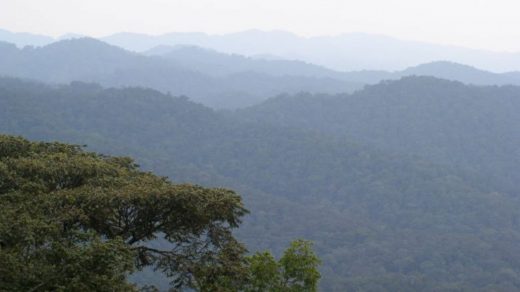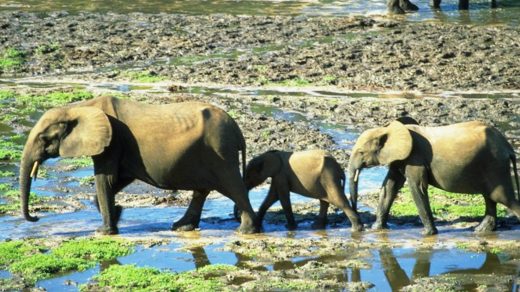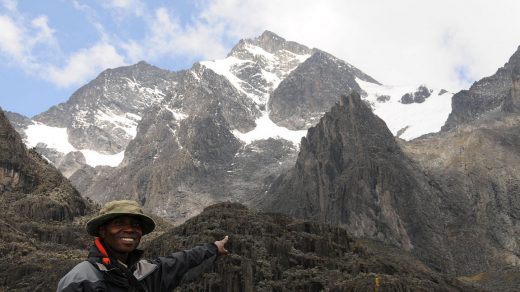The Eastern lowland gorilla (Gorilla beringei graueri) is a subspecies of the Eastern gorilla, and can only be found in montane forests in the eastern part of the Democratic Republic of the Congo (DRC). It is also known as Grauer´s gorilla.
The Eastern lowland gorilla is listed as Critically Endangered on the IUCN Red List. The main threats are habitat loss and illegal hunting.
The eastern lowland gorillas grow bigger than the other gorilla subspecies, and are thus the largest primates in the world.
Distribution
The eastern lowland gorilla lives montane forests in eastern DRC.
Notable populations are found in the Kahuzi-Biega National Park, the Maiko National Park, the Tayna Gorilla Reserve, the Usala forest, and on the Itombwe Massif.
Eastern lowland gorillas are believed to currently occupy roughly 13% of their historical range.
During the last half-century, the region inhabited by eastern lowland gorillas in the Democratic Republic of the Congo has decreased from 8,100 square miles (circa 21,000 sq km) to 4,600 square miles (circa 12,000 sq km). Carrying out research has been difficult due to the ongoing violence and political instability in the region, so numbers must be taken with a grain of salt.
Population
In the mid-1990s, the estimated eastern lowland gorilla population in DRC was slightly less than 17,000. In 2004, only circa 5,000 eastern lowland gorillas remained in the wild, and by 2016 the number had dropped to 3,800 by 2016.
There are fewer eastern lowland gorillas than western lowland gorillas in the wild. Approximately 150,000 to 250,000 western lowland gorillas lived in the wild according to studies published in 2013 and 2015.
There is no zoo reproduction program for the eastern lowland gorilla subspecies, since only one individual of this subspecies is kept in a zoo. It is a female who live at the Antwerp Zoo in Belgium.
Threats
Main threats against the eastern lowland gorilla:
- Illegal hunting
- Habitat destruction, chiefly due to logging, mining and expanding agriculture.
- War and civil unrest in CDR and nearby countries that drive refugees into gorilla habitats. This tends to result in forestland being converted into farmland, and an increased demand for bushmeat – including meat from illegally killed gorillas.
Bushmeat
Conservation organisations have reported illegal poaching for bushmeat as the primary cause of decline in eastern lowland gorilla populations.
Driving forces behind a boosted demand for bushmeat (meat from wild animals) include war and violent unrest, as it drives refugees away from their normal occupations and closer to or even into gorilla habitats. Militia groups in the countryside are also known to eat bushmeat.
Logging and mining also have a tendency to cause an influx of new people to an area, with and increased demand for bushmeat as a result.
Gorilla meat only constitute a small proportion of the total bushmeat eaten in the region, but the hunting is still significant enough to cause a serious decline in gorilla populations.
War and civil unrest
As stated above, war and civil unrest can harm gorilla populations as refugees clear new farmland in gorilla habitats and increase the demand for bushmeat. War and civil unrest also harm gorillas in several other ways:
- In the past, there have been situations where government funding of national parks have stopped as a result of war or civil war.
- Governments or rebel groups can demand the disarming of park guards; either to increase their own control or simply because they want the weapons.
- Gorillas are killed when stepping on land mines or triggering booby traps in the forest and on forest paths.
- Violence and instability makes it difficult to uphold the law; poachers go unpunished.
- During a 15 year period, 190 park rangers were killed in the Virunga National Park.
Logging and mining in DRC
Logging and mining contributes to both habitat destruction and an increased demand for bushmeat.
Illegal logging is carried out both by legal landowners (without the correct logging permits) and by those who have no legal rights to the land. Also, it is quite common for legal concession holders to engage in illegal over-harvesting by logging outside the permitted areas or using non-permitted logging techniques.
International demand is a strong driving force behind the mining and logging operations in DRC, and foreign and multinational companies and their customers are directly and indirectly contributing to the decrease in gorillas. It should also be noted that some export companies are paying money to militias, thus helping to fund the ongoing civil war in DRC. In some cases, the transactions does not even involve cash – the militias receive military weaponry in exchange for desirable natural resources.
Examples of desirable natural resources from the region are cassiterite, wolframite and coltan. In 2007, cassiterite for 45 million USD was exported from DRC, alongside wolframite for 4.27 million USD and coltan for 5.42 million USD. Since then, the demand for coltan has increased notably, since it is used in mobile phones.
On July 22, 2007, ten gorillas were killed in Virunga National Park in retaliation for the park ranger´s interference with the illegal exportation of resources from the park.


